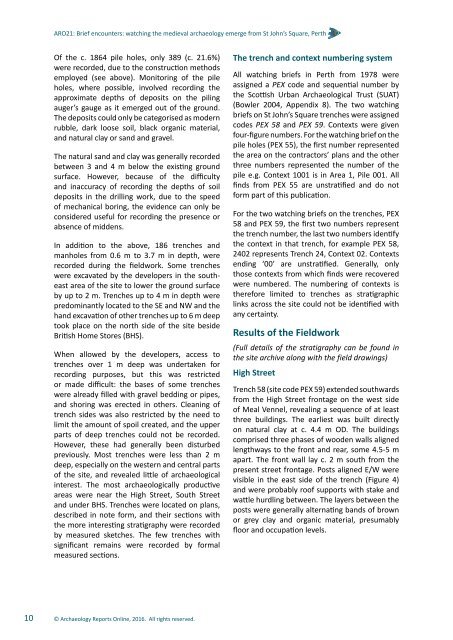medieval archaeology emerge from St John’s Square Perth
ARO21_St_Johns_Square
ARO21_St_Johns_Square
Create successful ePaper yourself
Turn your PDF publications into a flip-book with our unique Google optimized e-Paper software.
ARO21: Brief encounters: watching the <strong>medieval</strong> <strong>archaeology</strong> <strong>emerge</strong> <strong>from</strong> <strong>St</strong> <strong>John’s</strong> <strong>Square</strong>, <strong>Perth</strong><br />
Of the c. 1864 pile holes, only 389 (c. 21.6%)<br />
were recorded, due to the construction methods<br />
employed (see above). Monitoring of the pile<br />
holes, where possible, involved recording the<br />
approximate depths of deposits on the piling<br />
auger’s gauge as it <strong>emerge</strong>d out of the ground.<br />
The deposits could only be categorised as modern<br />
rubble, dark loose soil, black organic material,<br />
and natural clay or sand and gravel.<br />
The natural sand and clay was generally recorded<br />
between 3 and 4 m below the existing ground<br />
surface. However, because of the difficulty<br />
and inaccuracy of recording the depths of soil<br />
deposits in the drilling work, due to the speed<br />
of mechanical boring, the evidence can only be<br />
considered useful for recording the presence or<br />
absence of middens.<br />
In addition to the above, 186 trenches and<br />
manholes <strong>from</strong> 0.6 m to 3.7 m in depth, were<br />
recorded during the fieldwork. Some trenches<br />
were excavated by the developers in the southeast<br />
area of the site to lower the ground surface<br />
by up to 2 m. Trenches up to 4 m in depth were<br />
predominantly located to the SE and NW and the<br />
hand excavation of other trenches up to 6 m deep<br />
took place on the north side of the site beside<br />
British Home <strong>St</strong>ores (BHS).<br />
When allowed by the developers, access to<br />
trenches over 1 m deep was undertaken for<br />
recording purposes, but this was restricted<br />
or made difficult: the bases of some trenches<br />
were already filled with gravel bedding or pipes,<br />
and shoring was erected in others. Cleaning of<br />
trench sides was also restricted by the need to<br />
limit the amount of spoil created, and the upper<br />
parts of deep trenches could not be recorded.<br />
However, these had generally been disturbed<br />
previously. Most trenches were less than 2 m<br />
deep, especially on the western and central parts<br />
of the site, and revealed little of archaeological<br />
interest. The most archaeologically productive<br />
areas were near the High <strong>St</strong>reet, South <strong>St</strong>reet<br />
and under BHS. Trenches were located on plans,<br />
described in note form, and their sections with<br />
the more interesting stratigraphy were recorded<br />
by measured sketches. The few trenches with<br />
significant remains were recorded by formal<br />
measured sections.<br />
The trench and context numbering system<br />
All watching briefs in <strong>Perth</strong> <strong>from</strong> 1978 were<br />
assigned a PEX code and sequential number by<br />
the Scottish Urban Archaeological Trust (SUAT)<br />
(Bowler 2004, Appendix 8). The two watching<br />
briefs on <strong>St</strong> <strong>John’s</strong> <strong>Square</strong> trenches were assigned<br />
codes PEX 58 and PEX 59. Contexts were given<br />
four-figure numbers. For the watching brief on the<br />
pile holes (PEX 55), the first number represented<br />
the area on the contractors’ plans and the other<br />
three numbers represented the number of the<br />
pile e.g. Context 1001 is in Area 1, Pile 001. All<br />
finds <strong>from</strong> PEX 55 are unstratified and do not<br />
form part of this publication.<br />
For the two watching briefs on the trenches, PEX<br />
58 and PEX 59, the first two numbers represent<br />
the trench number, the last two numbers identify<br />
the context in that trench, for example PEX 58,<br />
2402 represents Trench 24, Context 02. Contexts<br />
ending ‘00’ are unstratified. Generally, only<br />
those contexts <strong>from</strong> which finds were recovered<br />
were numbered. The numbering of contexts is<br />
therefore limited to trenches as stratigraphic<br />
links across the site could not be identified with<br />
any certainty.<br />
Results of the Fieldwork<br />
(Full details of the stratigraphy can be found in<br />
the site archive along with the field drawings)<br />
High <strong>St</strong>reet<br />
Trench 58 (site code PEX 59) extended southwards<br />
<strong>from</strong> the High <strong>St</strong>reet frontage on the west side<br />
of Meal Vennel, revealing a sequence of at least<br />
three buildings. The earliest was built directly<br />
on natural clay at c. 4.4 m OD. The buildings<br />
comprised three phases of wooden walls aligned<br />
lengthways to the front and rear, some 4.5-5 m<br />
apart. The front wall lay c. 2 m south <strong>from</strong> the<br />
present street frontage. Posts aligned E/W were<br />
visible in the east side of the trench (Figure 4)<br />
and were probably roof supports with stake and<br />
wattle hurdling between. The layers between the<br />
posts were generally alternating bands of brown<br />
or grey clay and organic material, presumably<br />
floor and occupation levels.<br />
10<br />
© Archaeology Reports Online, 2016. All rights reserved.


